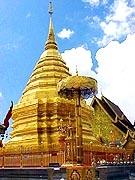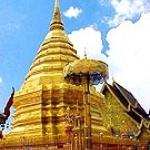Tour of Doi Suthep Temple in Chiang Mai Thailand
Created by "Welcome to Chiang Mai and Chiang Rai Magazine" and All Thailand Experiences
No trip to Chiang Mai would be complete without visiting Wat Phra Thart Doi Suthep; the spectacular Buddhist temple that can be seen, from wherever you happen to be in the city, clinging to the mountainside near the summit of Doi Suthep.
Doi Suthep hill has been seen as a holy place for more than twelve hundred years. The original inhabitants, the Lua, believed that the souls of their ancestors resided on the hilltop. When Buddhism was embraced by the Siamese people, the hill became the epicentre of the universe, and the centre of Buddhism in Lanna.
The temple was built in the late 14th century under King Geu Na, and attracts many pilgrims and tourists, both local and international, throughout the year.
Overlooking Chiang Mai from its lofty perch, some 3,500 feet (1,053 meters) above sea level, the temple is best visited on days free of cloud or heat haze; the view of the city, and the Ping valley beyond, is breathtaking.
The temple lies roughly 15 kilometres from the city, and can be reached by road. From the car park across the road from the temple there are two ways of approaching this holy shrine: on foot, if you are fit enough to climb the 306 steps up an almost vertical Naga (serpent) staircase, or by the small cable car (20 20 Baht). Most people choose the latter.
Once there, the climb, or the wait for the cable car is rewarded by the grandeur of this magnificent Lanna-style wat. The main deck comprises several pavilions with red-tiled roofs. There were a tower of large bell and Sal ("Sala" in Thai) tree to the right (The tree could be reformed as an anspicious tree that provided Lord Buddha as a unborn baby who was about to be delivered by his mother). Move on the clockwise walk : A junior bell tower, a Shrine of Thao Mahaprom (Brahma) Statue, a Shrine of Hermit Statue of Sudeva whose name for Doi Suthep as well as Suthep road, a Bodhi tree ("Po" in Thai) was brought from India, Lord Buddha spent many years for self-taught under that tree. A white elephant statue, the symbol of the elephant who carried the Buddha's relic to the hilltop, gards the pagoda and welcome the visitors. Turning back and step through an archway from the main deck, one enters cool closters surrounding a stunning, golden painted pagoda, or chedi; one of the most sacred in all Thailand.
Our present king, Bhumibol Adulyadej, donated the glass tip on the golden lotus petals at the top of the pagoda in the Lanna Chiangsaen design. When the main Wiharn or chapel's renovation was completed 40 years ago, the king presided over the installation of the golden Buddha image.
In the north direction from the golden Pagoda, it is a smaller Wiharn.
As visitors walk through the rectangular shaped terrace around the main chapel and pagoda, they will see no fewer than 47 wall paintings.These murals illustrate the lives of Buddha and the Jataka(Shadok) tales of Buddha's past lives before he reached the state of Nirvana. Although he lived many lives, it is the ten immediately preceding his birth that are most important to Thai Buddhists.
Within the pavilions are living quarters and a school for monks. Novices are sent here to study the teachings of the Lord Buddha, and to be educated in broadly the same subjects as are taught in every other school in the country.
At the east side, there is a wooden Wiharn. Keep walking toword antichockwise, there are many small bells. It is believed that good luck will come to the visitor who strikes the series of bells to be found here. A white balustrade surrounds the main deck, providing excellent views of the surrounding countryside. There is a small museum containing ancient relics and photographs. Walking to the westside, there is a snack bar and souvenir shop. Opposite between the the snack bar and the souvenir shop, it is Bhote or Pra Ubosote where all ordination services and prayers take place.
A Ceylonese monk, Sumana, came to spread Theravada Buddhism to the people of the Srisajjanalai and Sukothai kingdoms. He dreamt that the supreme being appeared before him and urged him to unearth the Buddha's relic at the site of the pagoda's ruins.He took the relic to the king of Srisajjanalai who was delighted, and ordered that a special mansion be erected for the relic's safekeeping. Sumana was then invited to show the relic to the king of Sukothai, but when no miracle followed the king doubted the authenticity of the relic and told Sumana to take it away with him. As a devoted Buddhist, King Gue Na sent a delegation to Sukothai to invite Sumana to Chiang Mai. The monk traveled to northern Thailand, stopping at Lumpoon, where he stayed for two years. On arrival in Chiang Mai, he stayed at Wat Boobparaam, or Wat Suan Dawg, and discussed the building of a sacred pagoda to house the relic. When he removed the relic from its packaging, he found that it had split into two pieces. They decided that one piece should be housed at Wat Suandawg, and the other would be housed in a special place.
Legend has it that the site of the temple was chosen in a most unusual way. King Geu Na ordered that a relic of the holy Buddha was strapped to the back of a sacred white elephant, and the beast was turned loose. After crashing its way up the densely forested mountainside, the elephant stopped just short of the summit of Doi Suthep, trumpeted its last breath and fell dead to the ground.
The king ordered that a golden pagoda be built where the elephant lay, and the Buddha relic to be housed therein. The wat was then constructed around the golden chedi.
Indeed, the more hardy visitors, having reached the top of the Naga staircase, will find a memorial to the sacred white elephant to their left.
Later, in the reign of King Phra Muang Ketklao in 1552, the structure was heightened and modified to its present state.
The multi-faceted chedi is in the shape of a bell, in unique Lanna style.
The temple has withstood two earthquakes, suffering minor damage in the first and more serious devastation during the second, leading to extensive repairs being carried out. Owing to the vast amount of daily visitors to the temple, structural work has been completed to strengthen and support the grand terrace.
During the construction of the road up to the Temple of the Holy Relic, the builder monk, Kruba Sriwichai, created several temples along the route. From the bottom of the hill, where a memorial to this most revered monk is to be found on the left hand side, if the visitor travels but a short way he will find Wat Sisoda; one of three temples built to signify the attainment of enlightenment in stages, with the hilltop shrine of the holy relic representing the ultimate goal of Nirvana.
Wat Sakithakha and wat Anakha, sadly, did not survive; only Wat Sisoda remains there today.
People living in northern Siam, as it was then, firmly believed that the Lord Buddha's holy relic was on Doi Suthep. In the beginning, shrines were built in city centres in accordance with the Central region's Wat Mahathart as the mythological hill of Semeru, the epicenter of the universe.
Both beliefs were reconciled by animistic people who, in a later period, embraced Buddhism. Wat Phra Thart Doi Suthep is believed to be the model for similar places of worship built in hilltops throughout Northern Thailand.
Take a tour of North Thailand's famous temples with All Thailand Experiences
 ThingsAsian
ThingsAsian

















